Potřebujeme váš souhlas k využití jednotlivých dat, aby se vám mimo jiné mohly ukazovat informace týkající se vašich zájmů. Souhlas udělíte kliknutím na tlačítko „OK“.
ASTM D4428/D4428M-14
Standard Test Methods for Crosshole Seismic Testing (Withdrawn 2023)
Automaticky přeložený název:
Standardní zkušební metody pro Crosshole seizmické testování
NORMA vydána dne 1.3.2014
Informace o normě:
Označení normy: ASTM D4428/D4428M-14
Poznámka: NEPLATNÁ
Datum vydání normy: 1.3.2014
Kód zboží: NS-27177
Počet stran: 7
Přibližná hmotnost: 21 g (0.05 liber)
Země: Americká technická norma
Kategorie: Technické normy ASTM
Kategorie - podobné normy:
Zemní práce. Hloubicí práce. Budování základů. Podzemní práce
Anotace textu normy ASTM D4428/D4428M-14 :
Keywords:
accelerometers, compression waves, geophones, machine foundations, seismic waves, shear waves, wave velocity, ICS Number Code 93.020 (Earth works. Excavations. Foundation construction. Underground works)
Doplňující informace
| Significance and Use | ||||||
|
5.1 The seismic crosshole method provides a designer with information pertinent to the seismic wave velocities of the materials in question (1).2 This data may be used as follows: 5.1.1 For input into static/dynamic analyses; 5.1.2 For computing shear modulus, Young's modulus, and Poisson's ratio (provided density is known or assumed); 5.1.3 For determining Seismic Site Class using the appropriate Building Code; and 5.1.4 For assessing liquefaction potential. 5.2 Fundamental assumptions inherent in the test methods are as follows: 5.2.1 Horizontal layering is assumed. 5.2.2 Snell’s law of refraction applies to P-waves and S-waves and to the velocities derived from crosshole tests. If Snell’s law of refraction is not considered in the analysis of Crosshole seismic testing data, the report shall so state, and the P-wave and S-wave velocities obtained may be unreliable for certain depth intervals near changes in stratigraphy 1.1 These test methods are limited to the determination of the velocity of two types of horizontally travelling seismic waves in soil materials; primary compression (1.2 Acceptable interpretation procedures and equipment, such as seismic sources, receivers, and recording systems are discussed. Other items addressed include borehole spacing, drilling, casing, grouting, deviation surveys, and actual test procedures. 1.3 These test methods are primarily concerned with the actual test procedure, data interpretation, and specifications for equipment which will yield uniform test results. 1.4 All recorded and calculated values shall conform to the guide for significant digits and rounding established in Practice D6026. 1.4.1 The procedures used to specify how data are collected/recorded and calculated in these test methods are regarded as the industry standard. The procedures used do not consider material variation, purpose for obtaining the data, special purpose studies, or any considerations for the user’s objectives. Measurements made to more significant digits or better sensitivity than specified in these test methods shall not be regarded a nonconformance with this standard. 1.5 Units—The values stated in either SI units or inch-pound units [presented in brackets] are to be regarded separately as standard. The values stated in each system may not be exact equivalents; therefore, each system shall be used independently of the other. Combining values from the two systems may result in non-conformance with the standard. Reporting of test results in units other than SI shall not be regarded as nonconformance with this test method. 1.6 This standard does not purport to address all of the safety concerns, if any, associated with its use. It is the responsibility of the user of this standard to establish appropriate safety and health practices and determine the applicability of regulatory limitations prior to use. |
||||||
| 2. Referenced Documents | ||||||
|
Podobné normy:
Historická
1.5.2011
Historická
1.5.2011
Historická
15.6.2009
Historická
1.10.2008
Historická
1.3.2013
Historická
1.7.2008
Doporučujeme:
Aktualizace technických norem
Chcete mít jistotu, že používáte pouze platné technické normy?
Nabízíme Vám řešení, které Vám zajistí měsíční přehled o aktuálnosti norem, které používáte.
Chcete vědět více informací? Podívejte se na tuto stránku.


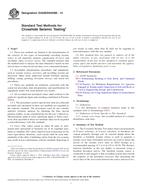
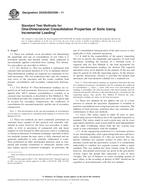 ASTM D2435/D2435M-11..
ASTM D2435/D2435M-11..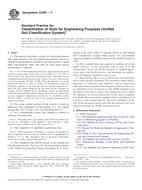 ASTM D2487-11
ASTM D2487-11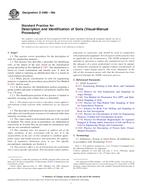 ASTM D2488-09a
ASTM D2488-09a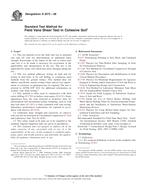 ASTM D2573-08
ASTM D2573-08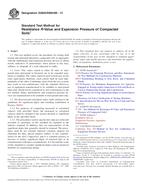 ASTM D2844/D2844M-13..
ASTM D2844/D2844M-13..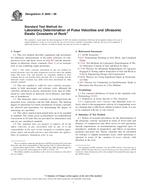 ASTM D2845-08
ASTM D2845-08
 Cookies
Cookies
